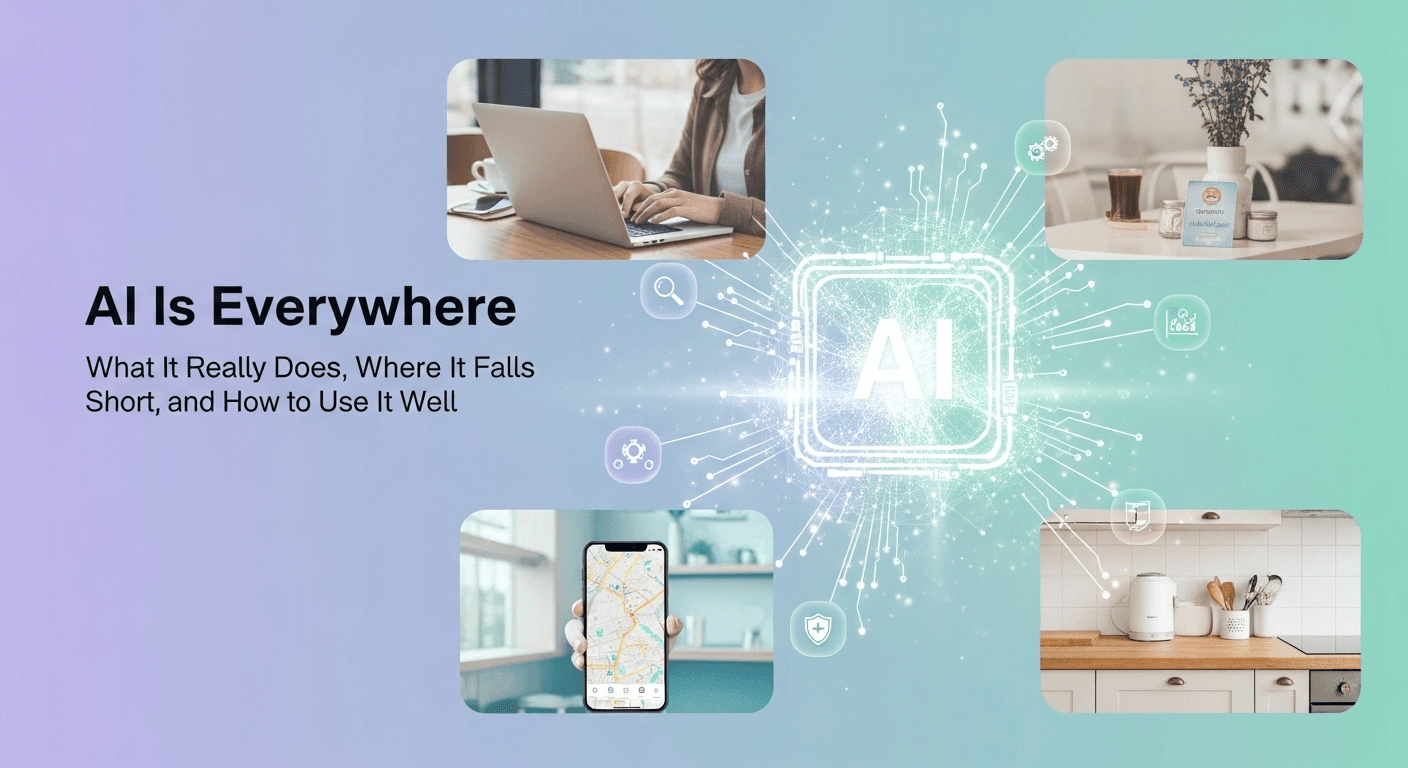AI Is Everywhere: What It Really Does, Where It Falls Short, and How to Use It Well

Introduction
Artificial intelligence is everywhere right now. It drafts emails, suggests headlines, summarizes meetings, and answers questions in seconds. Some people fear it will replace them; others already use it as a daily sidekick. Here’s the balanced truth: AI isn’t here to be human. It’s a powerful tool that spots patterns and predicts what comes next. With the right human guidance, it can help you work faster and think better. But used blindly, it can mislead you. Used wisely, it can multiply your impact.
This guide explains what modern AI actually does, why it sometimes fails spectacularly, and how to get real value from it without losing your judgment. We’ll also cover what regulators are doing and how to stay responsible as this technology becomes more common.
What AI Really Does (In Plain English)
At its core, today’s most popular AI is built on large language models (LLMs). They are trained on vast amounts of text to do one thing: predict the next piece of text (a “token”) based on the ones that came before it. That’s it. There’s no inner self that “understands” or “believes.” It’s a statistical engine that has learned patterns from data and is extremely good at continuing sequences in plausible ways.
Why AI Can Feel Smart Without Being Sentient
- Pattern mastery isn’t comprehension. LLMs can sound insightful because human language is full of meaningful patterns. But a system trained only on linguistic form doesn’t automatically understand the real world.
- Fast progress doesn’t change the core goal. Even as models get better, their fundamental training objective remains prediction based on patterns, not understanding the world as people do.
The Limits: Hallucinations, Bias, and Overconfidence
- Hallucinations. AI can generate fluent, confident statements that are factually wrong or completely fabricated. This is why high-stakes applications require human verification.
- Bias. AI models can reflect and amplify biases found in their training data. Managing AI bias is a socio-technical challenge that requires better datasets, algorithms, processes, and oversight.
- Over-trust. Because AI-generated text looks so polished, it’s tempting to accept it at face value. Treat AI like a talented intern: helpful, fast, sometimes brilliant, and sometimes confidently wrong. You are always the final editor.
What AI Is Great At Today
- Drafting and brainstorming: Creating first drafts of emails, summaries, outlines, and proposals.
- Data distillation: Turning long documents into concise bullet points or checklists.
- Pattern-heavy tasks: Classifying items, generating creative variations, and drafting code snippets.
- Language assistance: Rewriting text for clarity or tone, translating, and simplifying jargon.
Where Humans Still Shine
- Judgment under uncertainty: Weighing trade-offs, ethics, and context that isn’t in the training data.
- Original strategy and taste: Deciding what truly matters and why.
- Accountability: Owning the final decisions and their outcomes.
Evidence: AI + Humans Can Be More Productive
A randomized study found that access to ChatGPT reduced the time to complete common writing tasks by about 40% and increased measured quality by 18%. This shows that learning these tools can be a powerful advantage, as long as you maintain high standards.
Organizations are also moving from experiments to practice. At Boston Consulting Group, internal reports show widespread daily AI use and formal expectations around AI skills, all while reinforcing the importance of human judgment.
The Job Outlook: Change, Not Just Replacement
Globally, employers expect a significant rebalancing of tasks between humans and machines, with many new roles emerging. The World Economic Forum’s 2025 Future of Jobs report projects a net increase of jobs by 2030, paired with major shifts in required skills, especially in AI, data, and collaboration. Upskilling isn’t optional—it’s the plan.
How to Get Reliable Results: A Practical Playbook
- Start with a clear brief. Be explicit about your desired outcome: audience, goal, constraints, tone, and format. Provide examples of the output you want whenever possible.
- Structure your prompts. Separate instructions, inputs, and examples so the model doesn’t confuse them. Simple tagging or section breaks can significantly boost accuracy.
- Ask for sources and steps. For analysis and synthesis, ask the model to list its reasoning steps or cite specific passages from materials you provided. This helps ground its output in facts.
- Use retrieval and grounding. For factual work, connect the model to an authoritative source of truth (like your company’s documents or a curated knowledge base). This reduces hallucinations and keeps answers relevant to your content.
- Keep a human in the loop. Build a review step into your workflow, especially for high-stakes tasks. This aligns with frameworks like the NIST AI Risk Management Framework, which recommends governance, measurement, and ongoing monitoring.
- Iterate and test. Treat your prompts like a product. Try variations, evaluate the results, and create a library of prompts that work well for your specific use cases.
Working Examples: Everyday and Professional Use
- Emails and Docs: Provide the key points, audience, and desired tone. Ask for a 150-word draft and a 50-word version. Then, edit for your voice.
- Research Support: Paste a long article and ask for a 5-bullet summary and 3 open questions. Always verify the claims before using them.
- Code Assistance: Ask for a function stub, docstrings, and test cases. Then, run and review the code locally.
- Analysis: Feed in structured data and ask for 3 insights, 2 risks, and 2 follow-up questions. Inspect the output against your own domain knowledge.
Safety and Responsibility: A Brief Look at the Rules
- EU AI Act. The European Union’s AI Act entered into force on August 1, 2024, with obligations being phased in through 2026. If you operate or sell in the EU, it’s time to start aligning with these new regulations.
- U.S. Guidance. In the U.S., NIST’s AI Risk Management Framework (AI RMF 1.0) and its Generative AI Profile are widely used by companies to build governance programs that emphasize measurement and continuous monitoring.
Sustainability: The Hidden Footprint
AI’s growth comes at an environmental cost. Data centers require significant energy and water for computing and cooling. The U.S. Department of Energy reports that data centers consumed about 4.4% of national electricity in 2023 and could reach up to 12% by 2028, partly driven by AI. Water usage is also a major concern. These trends highlight why responsible AI deployment must include efficiency measures and transparency.
If you use AI at scale, ask your cloud vendors for their energy and water disclosures and their plans to reduce environmental intensity over time.
A Quick Reality Check on Common Claims
- “AI understands me.” It models patterns in language, which is useful but not the same as human comprehension.
- “Hallucinations are solved.” Not yet. Mitigation methods help, but human verification remains essential for accuracy.
- “Prompting is a fad.” Clear instructions measurably improve outcomes and reduce rework, especially for complex tasks.
Your New Edge: Better Questions, Better Results
AI amplifies good inputs. The more precisely you articulate your intent, the better the output. This is why prompting has become a valuable skill—it’s how you translate your judgment and context into instructions a model can follow. If you treat AI as a partner rather than a replacement, you can offload the drudgery while keeping your creativity, taste, and ethics at the center of your work.
Further Reading and Useful Links
- Stanford’s AI Index: A data-rich overview of trends in AI progress, costs, and governance. https://aiindex.stanford.edu/
- NIST AI Risk Management Framework: https://www.nist.gov/publications/artificial-intelligence-risk-management-framework-ai-rmf-10 and the Generative AI Profile: https://www.nist.gov/publications/artificial-intelligence-risk-management-framework-generative-artificial-intelligence
- EU AI Act Overview: https://commission.europa.eu/news/ai-act-enters-force-2024-08-01_en and Timeline: https://iapp.org/resources/article/eu-ai-act-timeline/
- MIT Study on Productivity: https://news.mit.edu/2023/study-finds-chatgpt-boosts-worker-productivity-writing-0714
- Prompt Engineering Best Practices (Anthropic): https://docs.anthropic.com/en/docs/build-with-claude/prompt-engineering/use-xml-tags and https://docs.anthropic.com/en/docs/build-with-claude/prompt-engineering/long-context-tips
Conclusion
AI is everywhere, but it isn’t magic. It’s a prediction machine that becomes powerful when you guide it with clarity, context, and high standards. Let it draft; you decide. Let it suggest; you verify. Pair its speed with your judgment, and you’ll get the best of both worlds.
FAQs
Q1) Does AI actually understand what I say?
A1) No, not in a human way. LLMs recognize patterns to predict the most likely next words. This produces useful results, but it’s not true comprehension. Always apply your own judgment to important decisions.
Q2) Why does AI sometimes make things up?
A2) The model is designed to fill gaps by predicting plausible text. If it lacks factual information, it can generate fluent but incorrect statements (“hallucinations”). To prevent this, provide source material and always review its output for accuracy.
Q3) Is AI safe to use at work?
A3) Yes, with the right safeguards. Use internal data responsibly, restrict access to sensitive content, ground answers in approved sources, and always require human review. Following frameworks like the NIST AI RMF can help you manage risks effectively.
Q4) Will AI take my job?
A4) It’s more likely to change your job. As routine tasks become automated, new roles and skills are emerging. The best way to prepare is to build your skills in AI, data literacy, and collaboration.
Q5) What about AI’s environmental impact?
A5) Data centers consume a significant amount of electricity, and AI is increasing that demand. It’s important to push technology vendors for transparency and efficiency commitments to help mitigate the environmental impact.
Thank You for Reading this Blog and See You Soon! 🙏 👋
Let's connect 🚀
Latest Blogs
Read My Latest Blogs about AI

AI’s Uneven Takeoff: Insights from Anthropic’s 2025 Economic Index on Work Transformation
Discover insights from Anthropic's 2025 Economic Index, highlighting faster but uneven AI adoption trends. Understand where usage is concentrated and how enterprises are adapting.
Read more

